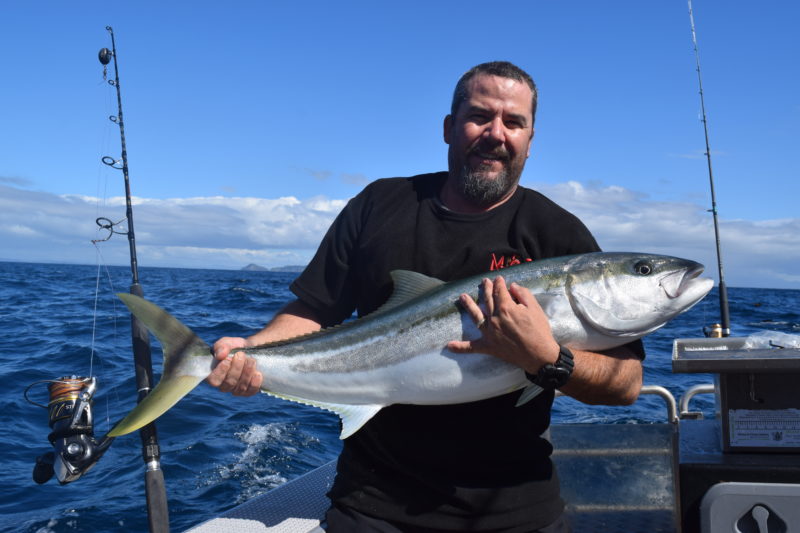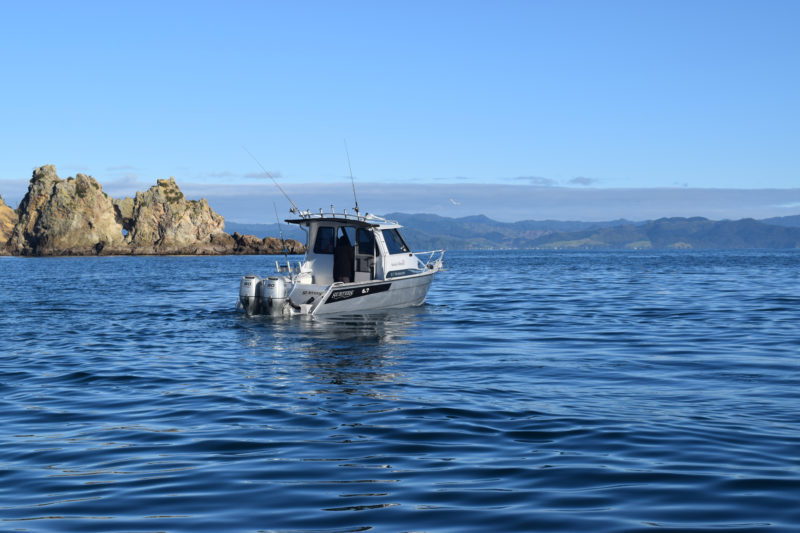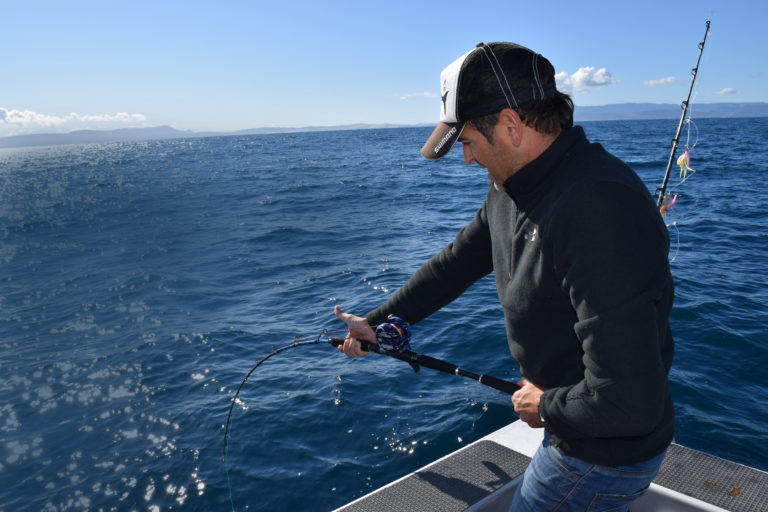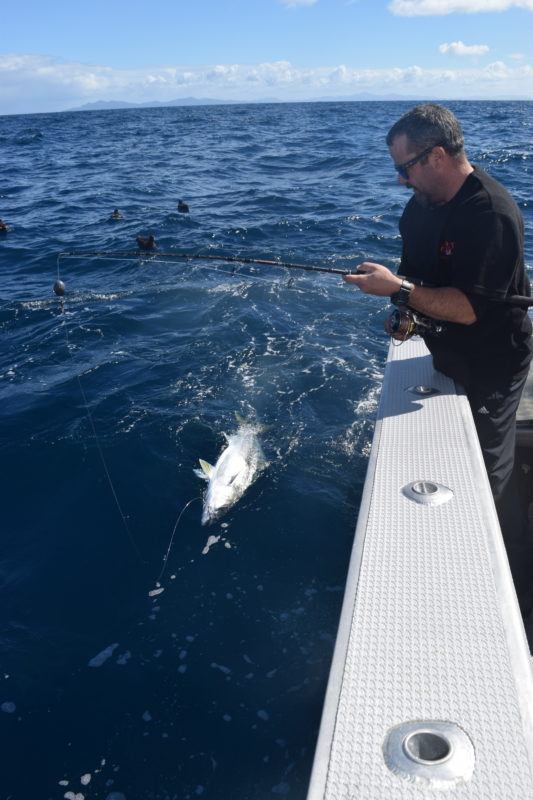Mat Hewetson discusses two key methods for targeting kingfish in deep water, both work well and will help you catch more of the tough, green-backed fighters.
Kingfish are one of our beloved fish species in New Zealand and up the top of most Kiwi anglers lists to catch. They fight hard when hooked and fresh kingfish for sashimi, pan fried or the smoker is a favourite. Most boaties head out to target snapper and might be lucky to hook-up to a kingie which is attracted to their bait, berley and struggling fish in the water from their resulting fishing.

However, if you really want to have more success with kingfish then you need to actively target them and there are two sure ways to increase your captures in deep water by using live baits and jigging.
Let’s examine both methods and what you will need.
Live Baits First
Kingfish can’t resist a live bait. Jack mackerels would be the best bait to offer them, followed by small kahawai, piper, squid or koheru. Jack mackerels are usually much easier to find and catch as they are common and found in large schools.
Getting up early and on the water, is well worth it as finding the schools can take time some days. The change of light is a perfect time to catch mackerel, if you have underwater lights and a berley trail going, you will see them and they are easy to catch.

Otherwise, you will need to spend time looking for the schools over shallow water reefs or sandy bays. Look for the bait schools on your sounder and drop sabikis, baited with tiny bits of pilchard on light rods and reel sets.
Keep moving if you have no luck until you find hungry fish. Take it steady reeling them up as they can easily fall off the small sabiki hooks. Put them into your live bait tank, if you don’t have one, you can use a large chilly bin but you will need to keep putting fresh sea water in every 10-15 minutes.
You will want to catch between 30-50 mackerel as some will die and it is surprising how many will get picked off the hooks without hooking up to a predator.
Tackle and Rig
You need to have a 15-24kg rod and reel set, preferably a lever-drag reel is best as you can set a light drag when the kingie takes the livie and push up the drag lever to set the hook.
I use a Shimano Tynos 30 and Kilwell 15-24kg roller tipped rod, spooled with 24kg braid and 80-120lb mono leader. Braid lets you keep in better contact with your live bait and the heavy mono leader is crucial as it helps prevent bust offs when the kingfish heads for cover in the reef or foul.

Use a running rig with a 2-4oz ball or egg shaped sinker sitting above the swivel, which is then attached with a long 8-10ft supple trace of 80-120lb mono, with a 4/0-7/0 circle hook on the end.
Sometimes you will need to use a smaller 4/0 circle hook if your live baits are small, this helps keep them alive as larger hooks are too heavy and they struggle to swim and die. These 4/0 circle hooks are surprisingly strong and good brands to consider are; Black Magic, Gamakatsu and Owner.
Make sure you have at least 80lb-120lb supple mono for leader, this is better for tying your knots and you need it to prevent bust offs.
Tactics
Going wide to fish in deeper water from 70-150m, you are looking for structure such as reefs, pins, wrecks or foul where bait schools gather and kingfish like to hunt. A good sounder is key, as you are searching to find where the kingfish are holding over the reef.
The edges are usually the best places to start and once in position, drop your live bait down to the bottom and retrieve several metres back so the livie is up off the bottom. Drift through your mark/structure slowly, the skipper needs to reverse when needed to keep the line vertical and always watching the sounder to identify the drop offs or edge of the structure.

Often the kingfish will be well up off the bottom, so use the sounder to identify what depth and then you can use the coloured braid depth breaks to put the livie in the zone. Eg, if your braid is coloured in 10m sections and the kingfish are holding over a reef at 60m, you need to count 6 colour changes of braid.
Your live bait will start to get nervous when it gets attention, you will notice the rod dipping and the line twitching. Once the weight starts to come on more, push the drag up and start winding. The circle hook will do its job and hopefully the hook will be embedded in the corner of the kingfish’s mouth. Don’t be surprised how many livies manage to get removed off the hook by kingfish, it may take a few livies before success. But at least you know they are producing the bites.
Jigging Tackle
Our other approach in deeper water is to jig for kingfish. Mechanical jigging with large jigs is very effective on kingfish as their predatory nature means they will chase down fast moving lures.
For this we need to switch to a different rod and reel set. A typical jigging rod is shorter and very strong, matched with either a high-speed ratio overhead reel or a spin reel that can hold 250-300m of 24-37kg braid.
Braid is crucial as you need to keep in direct contact with the jig and use them vertically, and braid has no stretch. The reels also need to have good drags, offering at least 10-12kg of drag to help put the hurt on big kingfish.

Again, you will need to tie an 80lb-120lb mono leader of approximately 10-15ft which is then connected straight to the solid, hook ring on the jig. The best knots for tying leader to the braid is the PR Knot or FG Knot, Google these online to show you as there are numerous videos available.
Take a selection of different weights and colours, from 200gm – 400gm jigs. Weight is more important than colour, on calm days with little current you can use lighter 200-250gm jigs. If there are stronger winds causing the boat to drift more quickly or there is more current, then heavier 300-400gm jigs are best.
Tactics
Again, when fishing deeper water over 70m+, you are looking for the same structure such as reefs, pins, or foul where kingfish like to hunt. Use the sounder to locate where the kingfish are holding over the mark, the skipper will need to keep you right above it.
Drop your jig down to the bottom and crank it back up using a quick half turn of the reel handle and a short lift on the rod at the same time. This makes the jig stall and jinx on its way up, mimicking an injured bait fish. It is an awkward style at first until you get into a good rhythm, but a lot of first time jiggers do well as their erratic style works.
As when live baiting, often the kingfish are well up off the bottom, so again use the sounder to identify what depth and use your coloured braid depth breaks to drop the jig to where the kings are. Eg, if the bottom is 130m and the kingfish sign is at 70m, you need to count 7 colour changes of braid. This means you are saving time and energy by not going all the way to the bottom!
Jigging is a fun and more active method of fishing for kingfish, but combined with live baiting and actively fishing in deeper water, you will see your kingfish catches increase.




